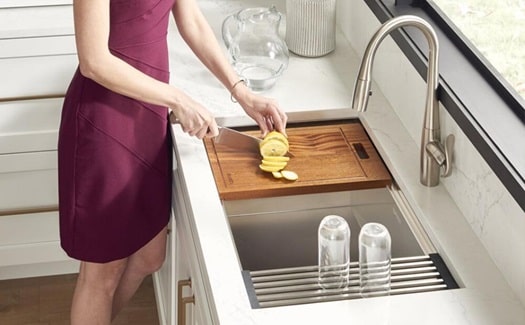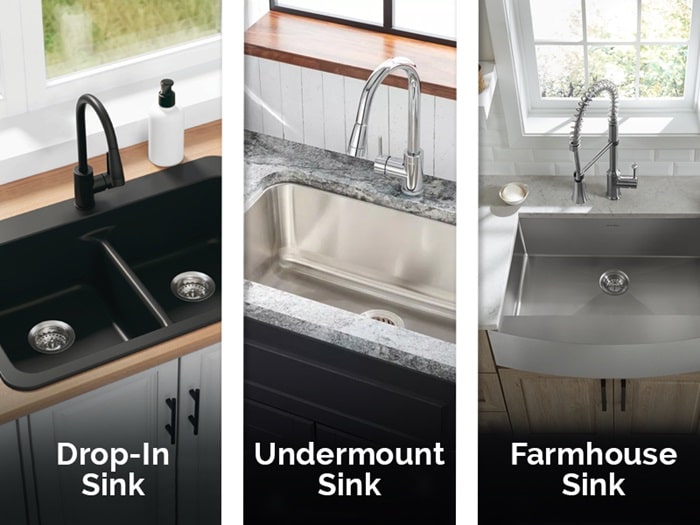The kitchen sink is one of any household's most frequently used fixtures. It is where we wash dishes, prep food, and even fill up water for our pets. However, not all kitchen sinks are created equal. Various materials, sizes, and styles make selecting the right sink for your kitchen a daunting task.
To help you, we've compiled the ultimate guide so that you can learn how to choose a kitchen sink.
What Is the Best Material for a Kitchen Sink?

When choosing a kitchen sink, consider several factors, including the material from which it's made. Different sink materials have unique advantages and disadvantages, so it's important to carefully evaluate your options before purchasing.
- Stainless Steel: Stainless steel is a top choice for kitchen sinks because of its durability, affordability, and ease of maintenance. These sinks can bear heavy use and resist stains, scratches, and corrosion. They also require minimal effort to clean and maintain, making them a great fit for busy kitchens.
- Cast Iron: Cast iron sinks are incredibly durable and can last decades with the right care. However, they require more maintenance than other sink materials, such as regular sealing and cleaning to prevent rust and stains.
- Granite Composite: These sinks are typically made from a mixture of acrylic resin and granite stone, which makes them incredibly durable and resistant to heat, scratches, and stains. They come in a wide range of colors and styles, making it easy to find one that complements your kitchen's decor.
- Fireclay: This ceramic material is fired at high temperatures, making it strong and non-porous. Fireclay sinks are a breeze to clean and maintain and have a classic look that suits various kitchen styles.
Think About the Size
Choosing the right sink size for your kitchen can be daunting. It depends on various factors, such as the size of your kitchen, your personal preferences, and your daily routine. A larger sink would be ideal for cleaning large pots and pans if you cook large meals frequently or entertain guests. However, a smaller sink would be more practical if you have a small counter space in your kitchen, as it would only take up a little space. Also, a smaller sink would be easier to clean and maintain than a larger one.
Choose the Installation Type
Choosing the right sink style can significantly impact your kitchen's look and feel. You have several options, including undermount, drop-in, and farmhouse sinks.
- Undermount sinks give a sleek and seamless look.
- In contrast, drop-in sinks can be installed easily and come in various materials.
- Farmhouse sinks offer a unique and rustic feel with a large basin and front-facing apron.
- Dual-mount sinks are popular because you can mount them above or below the counter.

Ultimately, deciding between sink styles will depend on your preferences and kitchen design. Take time and choose wisely to ensure your sink is practical and stylish.
Prioritize Functionality
Its functionality is decisive when selecting a kitchen sink. Think about how you plan to use the sink and what features it should have to meet your needs. For instance, if you have a busy household, you need a workstation sink to prep and clean in one place. It features integrated accessories, such as cutting boards, colanders, and drying racks, that provide a convenient workspace for food preparation and cleaning. The sink also helps keep your kitchen organized and clutter-free.
Consider the Accessories
Kitchen sinks have various accessories that make daily tasks more efficient. These include cutting boards, colanders, and drying racks. Cutting boards provide a convenient surface for chopping, colanders for rinsing off produce or draining pasta, and drying racks for drying dishes.
To determine which accessories you need, consider your habits and needs. If you frequently prepare meals that require a lot of cutting, a cutting board would be a valuable addition. If you wash a lot of produce, a colander can make rinsing fruits and vegetables a breeze. Drying racks are beneficial for those who prefer to hand wash their dishes.
Set a Budget
When purchasing a kitchen sink, it is crucial to set a budget. The cost of kitchen sinks can range from hundreds to thousands of dollars. By determining a budget, you can narrow your options and select a sink that meets your needs and fits your wallet. When considering your budget, include any additional costs, such as installation fees, plumbing costs, and accessories you may want to purchase along with your sink.
Consider the Color
Kitchen sinks are available in various colors, ranging from classic stainless steel to bold black and everything in between. Choosing a color that complements your kitchen's color scheme and enhances its overall aesthetic is important. If you have a neutral-colored kitchen, you can opt for a sink with a pop of color to add visual interest. Conversely, if you have a bold-colored kitchen, a sink with a more subdued color can provide balance and prevent the space from feeling overwhelming.
Choosing a Kitchen Sink....with PlumbersStock?
Choosing the right sink for your kitchen can be overwhelming, but this guide can help you find the perfect one for your needs. Remember, a kitchen sink is an investment that will last for years, so take the time to make the right choice.



